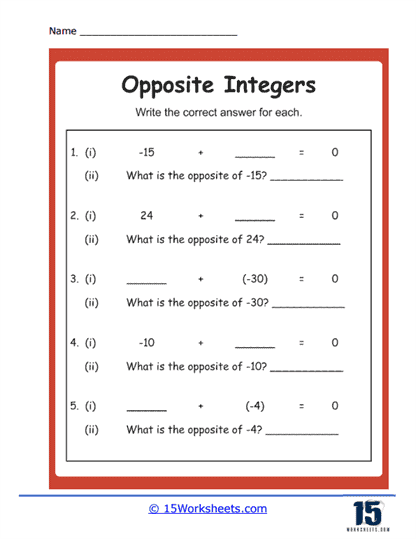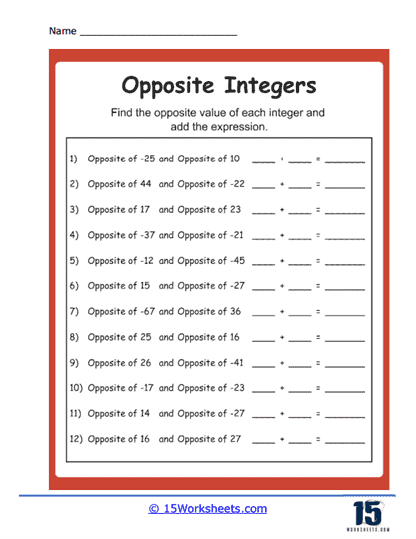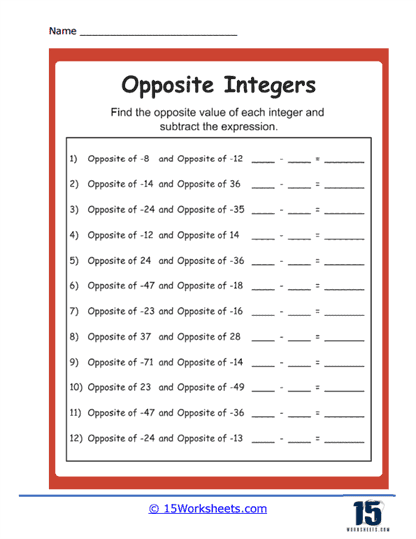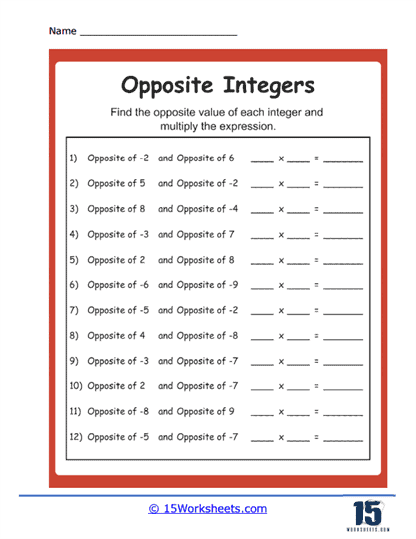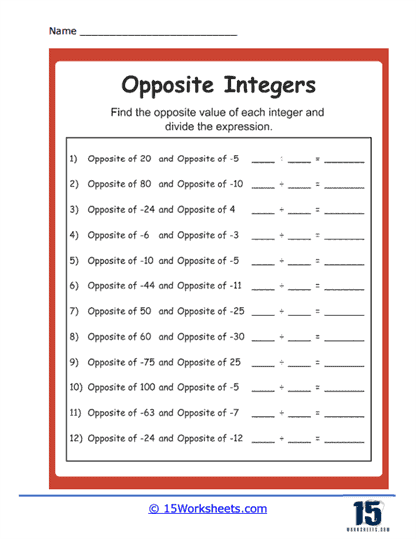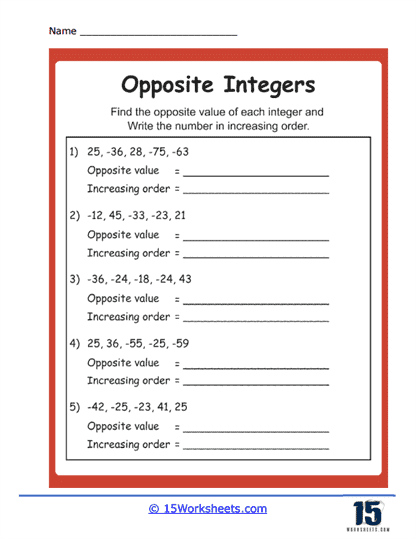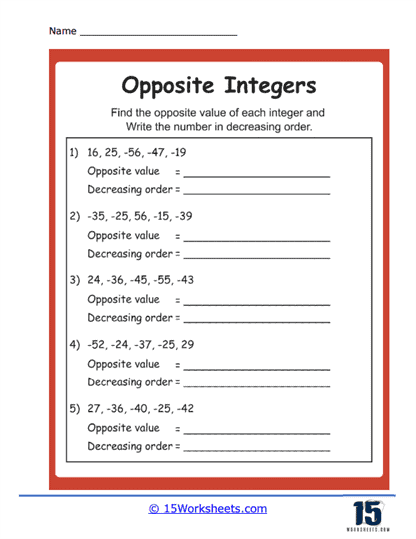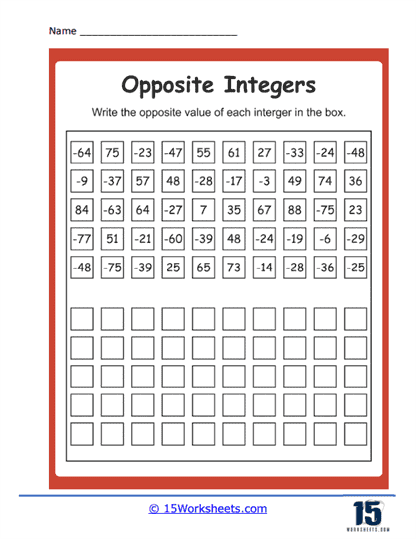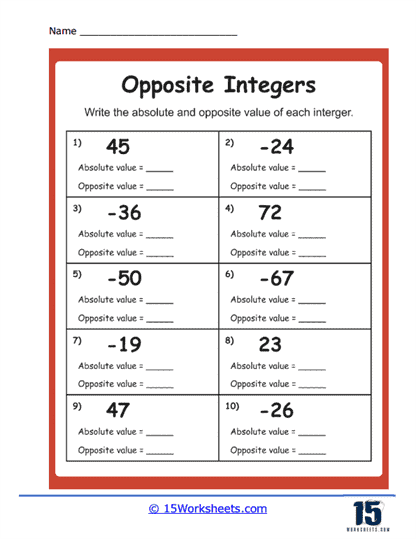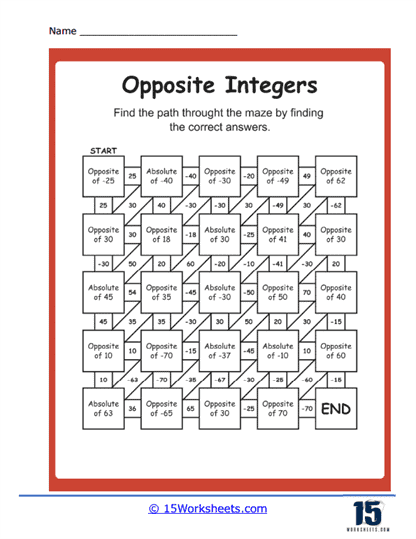Opposite Value of Integers Worksheets
About These 15 Worksheets
Every integer has an opposite. The opposite is just the same number but on the other side of zero. For example, the opposite of 5 is -5, and the opposite of -3 is 3. If you’re standing on the number line at 5 and you jump to the other side of 0, you’ll land on -5. That’s how you find the opposite!
By practicing these exercises, you’ll become a whiz at finding opposites in no time! Remember, every positive number has a negative twin, and every negative number has a positive twin. And these worksheets are the best way to meet and play with these number twins.
Types of Exercises on the Worksheets
Identify the Opposite – In this type of exercise, you’ll be given a list of integers, and you have to write their opposites.
Example Problem – Given – 4, -7, 2
Answer – -4, 7, -2
Matching Pairs – Here, you’ll see two columns. One column will have integers, and the other column will have their opposites, but they’ll be mixed up. Your job is to draw a line connecting each integer to its opposite.
Example Problem – Column A – 3, -5, 6
Column B – -3, 5, -6
Fill in the Blanks – This exercise will have sentences with blanks. You have to complete them using the correct opposite integer.
Example Problem – The opposite of 8 is _____.
Answer – -8
Opposite Ladders – Imagine a ladder. On one side, you have integers. On the other side, you have empty steps. You need to fill the empty steps with the opposite of each number.
Number Line Jumps – You will get a number line, and some integers will be marked on it. Your task is to draw an arrow from each marked integer to its opposite.
Example Problem – If the number 3 is marked, you would draw an arrow from 3 to -3.
Story Problems – These are short stories or situations where you need to think and find the opposite integer. They help you understand why knowing the opposites can be useful in real life.
Example Problem – Jenny had 5 apples and she ate them. How many apples does she need to get back to having 0 apples?
Answer – She needs -5 apples (or she has -5 apples now).
Color the Opposites – This is a fun exercise where you will get a group of numbers and some crayons. You’ll color in pairs of opposites with the same color.
Example Problem – If you see the numbers 4 and -4, you would color both of them blue (or any other color you choose).
Where Would You Use Opposite Integers in Your Daily Life?
Money Matters – When you spend money, it’s like using negative numbers because your money is going down. When you earn or save money, it’s like positive numbers. If you spent $5 (that’s -$5) and then earned $5, those are opposites, and they balance out to $0. So, understanding opposite integers can help you manage your pocket money or savings.
Temperature – Especially in places where temperatures can go below freezing, understanding negatives is crucial. If it’s 3°C today and the weather report says it will be 3 degrees colder tomorrow, it will be 0°C. If it gets 3 degrees colder the next day, it’ll be -3°C. This helps you prepare for cold days and understand how much the temperature has dropped.
Gaming – If you play video games, sometimes your character gains points (positive) and sometimes loses points (negative). For instance, gaining 10 points (+10) and then losing 10 points (-10) would bring you back to where you started.
Sports – In some sports, especially ones like golf, a negative score can be a good thing! If you’re keeping track of how many strokes over or under par you are, understanding negative numbers can help you know how well you’re doing.
Elevations and Floors – In some buildings, especially tall ones or those built into hillsides, there might be basement levels or floors below the ground level. These are often numbered as B1, B2, or -1, -2, etc. Understanding that -1 is the floor just below the ground level helps you navigate these buildings.
Traveling and Time Zones – If you travel from one time zone to another, you might have to adjust your watch forward (positive hours) or backward (negative hours). If it’s 3 PM where you are, and you travel to a place that’s 3 hours behind, you subtract those hours, which is like adding a negative number, and it becomes 12 PM.
Cooking and Baking – If you accidentally put too much of an ingredient, like salt, into a dish, you might need to balance it out with another ingredient, like water or tomatoes. This is a bit like adding a negative to counteract a positive!
Chores and Tasks – Imagine you have a list of 5 chores to do. Each time you complete a chore, you can think of it as -1 chore left to do. So if you do 3 chores, you subtract those from your total (5 – 3 = 2 chores left).
Exercise and Calorie Counting – If you’re keeping track of the calories you eat and the calories you burn from exercising, understanding negatives is useful. If you eat a cookie for +200 calories and then do an exercise that burns -200 calories, they balance each other out.
In essence, the concept of opposites in integers is all about balance. It helps us understand how things can cancel each other out or bring things back to a starting point. And as you can see, it pops up in a lot of places in our daily lives!






